
Additional data:
PHASE 2 STUDY
OF CABTREO
VS EPIDUO FORTE1
Clinically tested on multiple patient types1
Before-and-after photos from this clinical trial
12-YEAR-OLD WHITE FEMALE
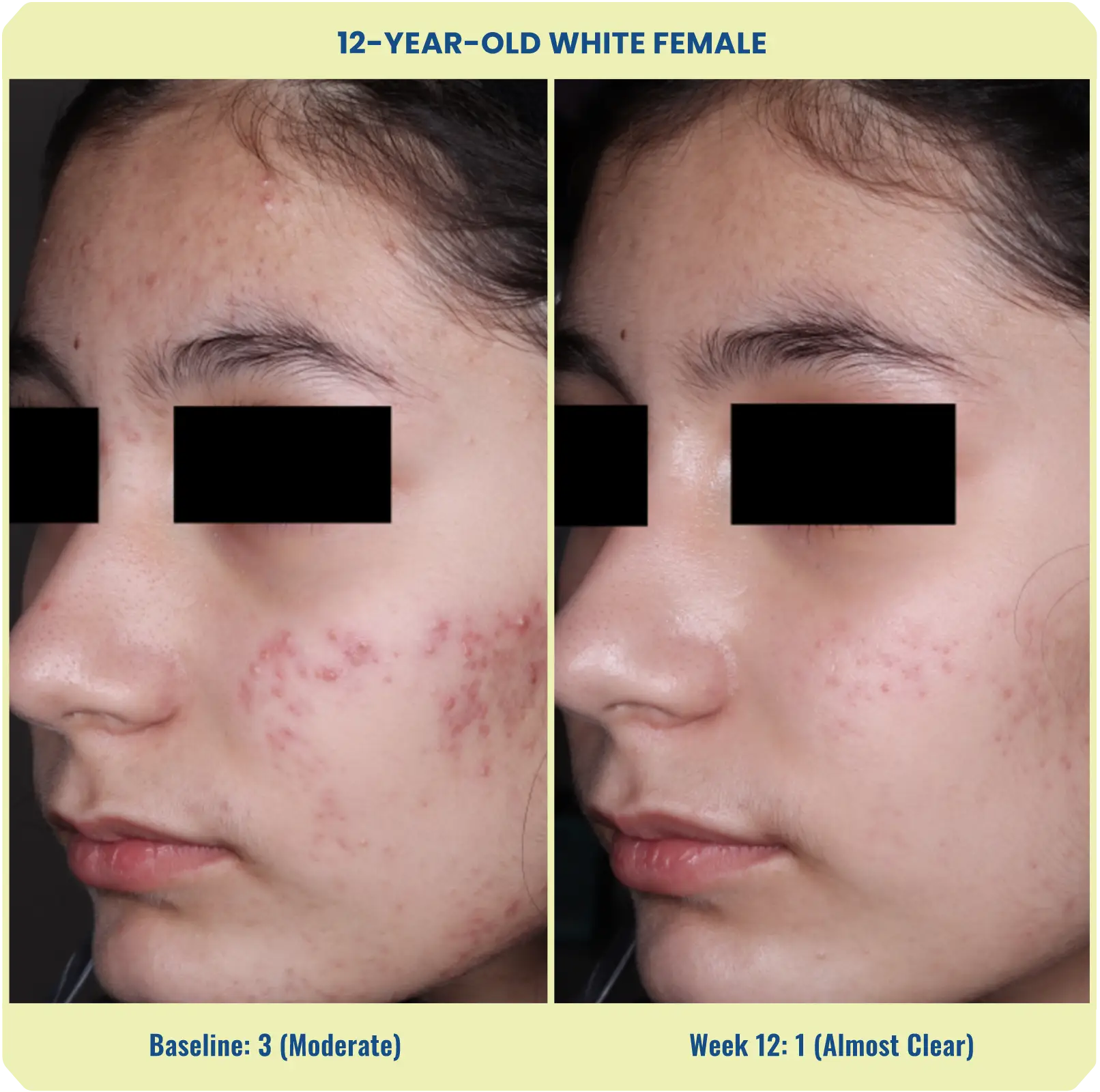
- Banseline 3 (Moderate)
- Week 12: 1 (Almost Clear)
- Inflammatory Lesion Count: 40
- Inflammatory Lesion Count: 0
- Noninflammatory Lesion Count: 40
- Noninflammatory Lesion Count: 2
Individual results may vary.
15-YEAR-OLD WHITE FEMALE
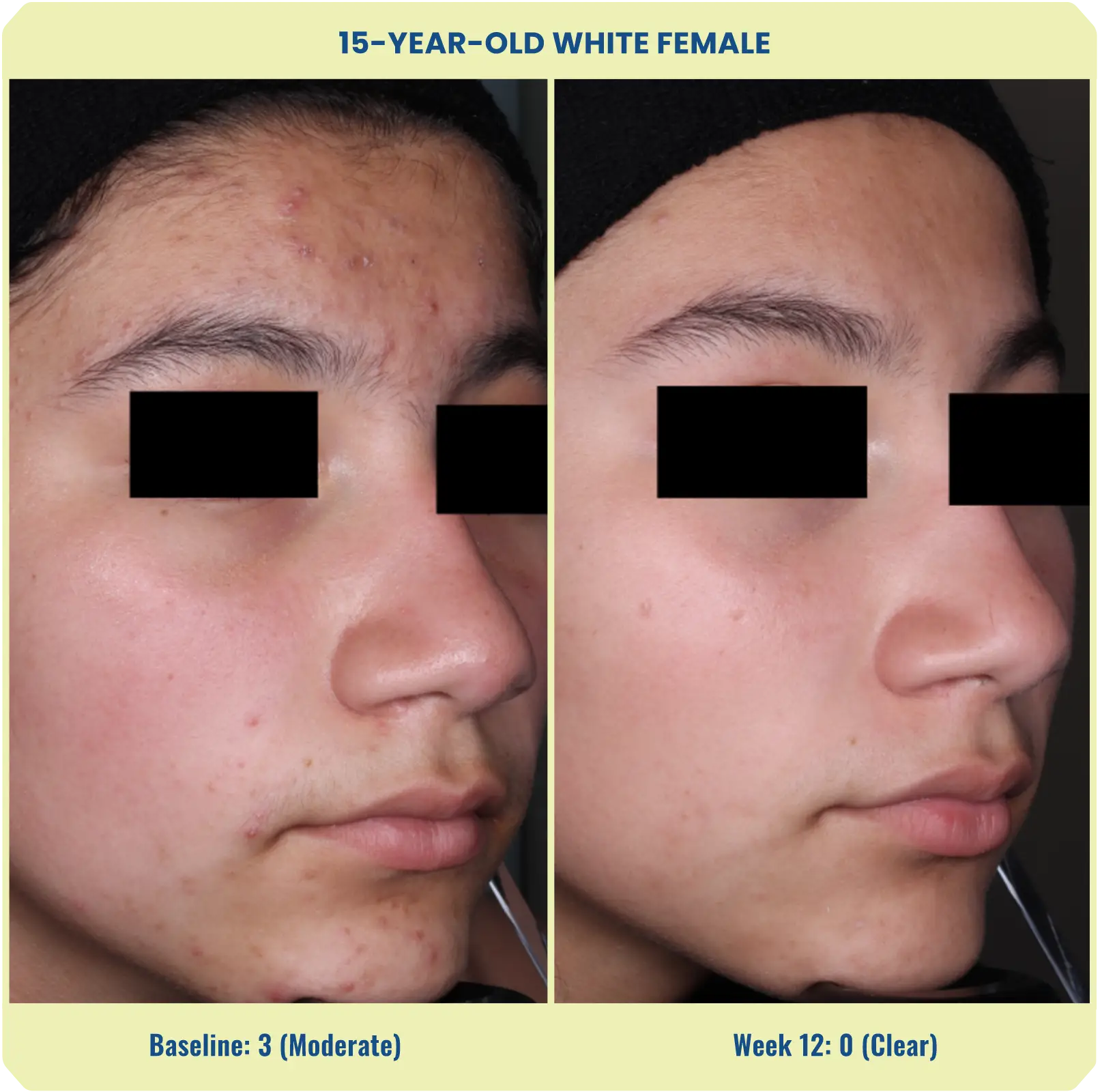
- Banseline 3 (Moderate)
- Week 12: 0 (Clear)
- Inflammatory Lesion Count: 53
- Inflammatory Lesion Count: 0
- Noninflammatory Lesion Count: 111
- Noninflammatory Lesion Count: 0
Individual results may vary.
16-YEAR-OLD WHITE FEMALE
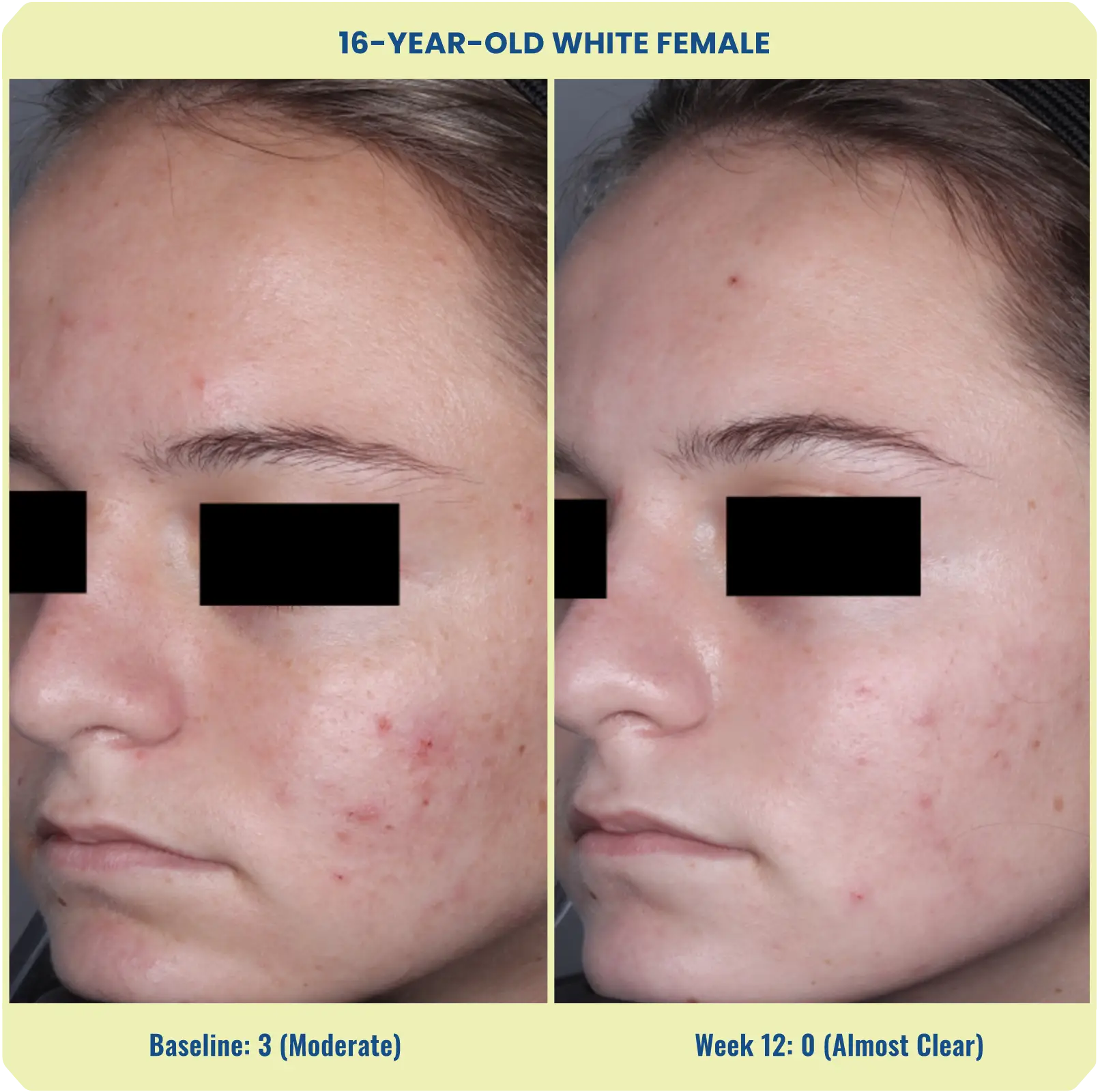
- Banseline 3 (Moderate)
- Week 12: 0 (Almost Clear)
- Inflammatory Lesion Count: 37
- Inflammatory Lesion Count: 6
- Noninflammatory Lesion Count: 36
- Noninflammatory Lesion Count: 9
Individual results may vary.
22-YEAR-OLD WHITE FEMALE

- Banseline 3 (Moderate)
- Week 12: 1 (Almost Clear)
- Inflammatory Lesion Count: 32
- Inflammatory Lesion Count: 1
- Noninflammatory Lesion Count: 37
- Noninflammatory Lesion Count: 0
Individual results may vary.
13-YEAR-OLD WHITE MALE
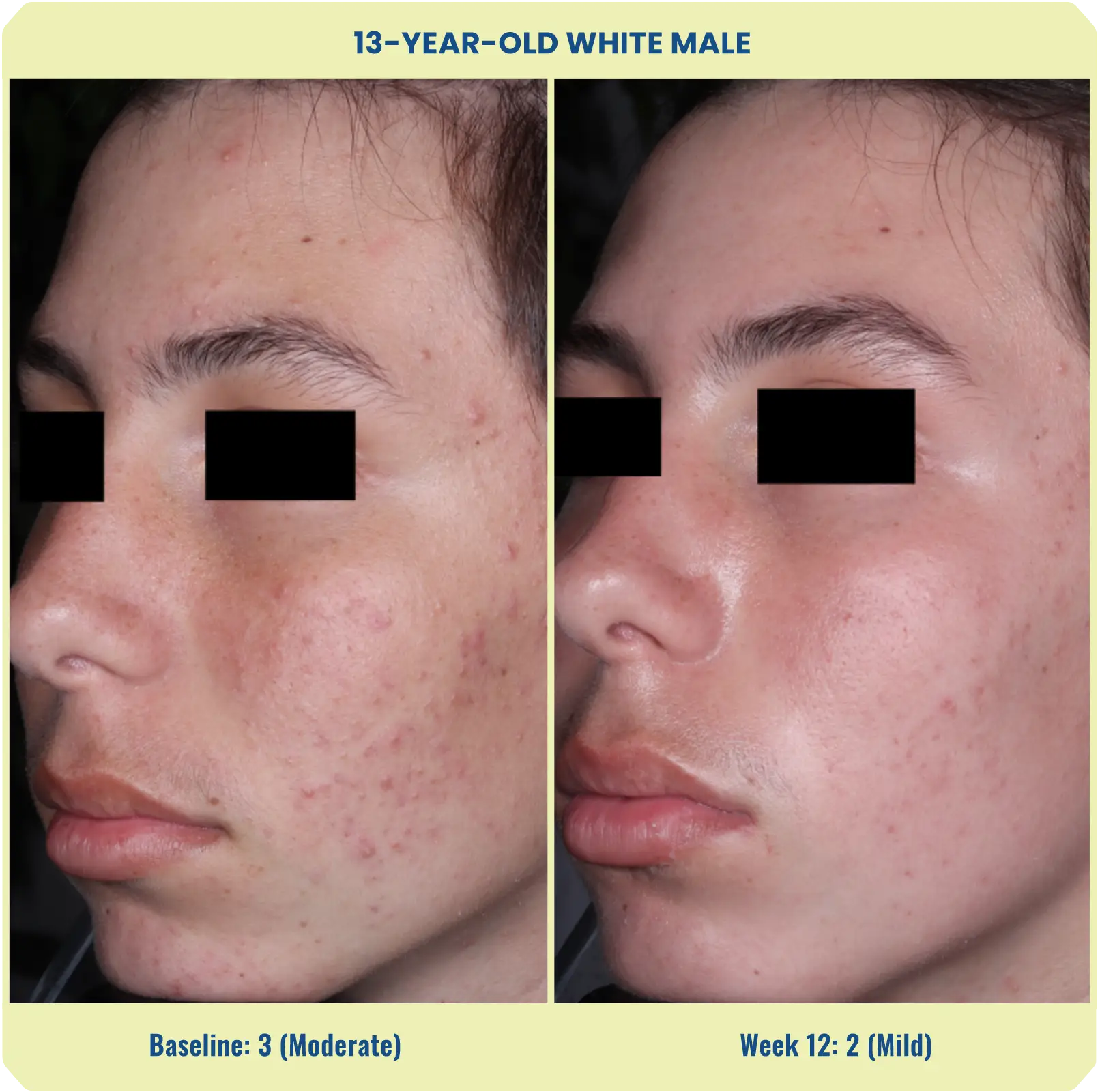
- Banseline 3 (Moderate)
- Week 12: 1 (Mild)
- Inflammatory Lesion Count: 30
- Inflammatory Lesion Count: 0
- Noninflammatory Lesion Count: 39
- Noninflammatory Lesion Count: 6
Individual results may vary.
14-YEAR-OLD ASIAN MALE

- Banseline 4 (Severe)
- Week 12: 1 (Almost Clear)
- Inflammatory Lesion Count: 51
- Inflammatory Lesion Count: 2
- Noninflammatory Lesion Count: 42
- Noninflammatory Lesion Count: 1
Individual results may vary.
15-YEAR-OLD BLACK MALE

- Banseline 3 (Moderate)
- Week 12: 1 (Almost Clear)
- Inflammatory Lesion Count: 32
- Inflammatory Lesion Count: 5
- Noninflammatory Lesion Count: 43
- Noninflammatory Lesion Count: 6
Individual results may vary.
17-YEAR-OLD WHITE MALE
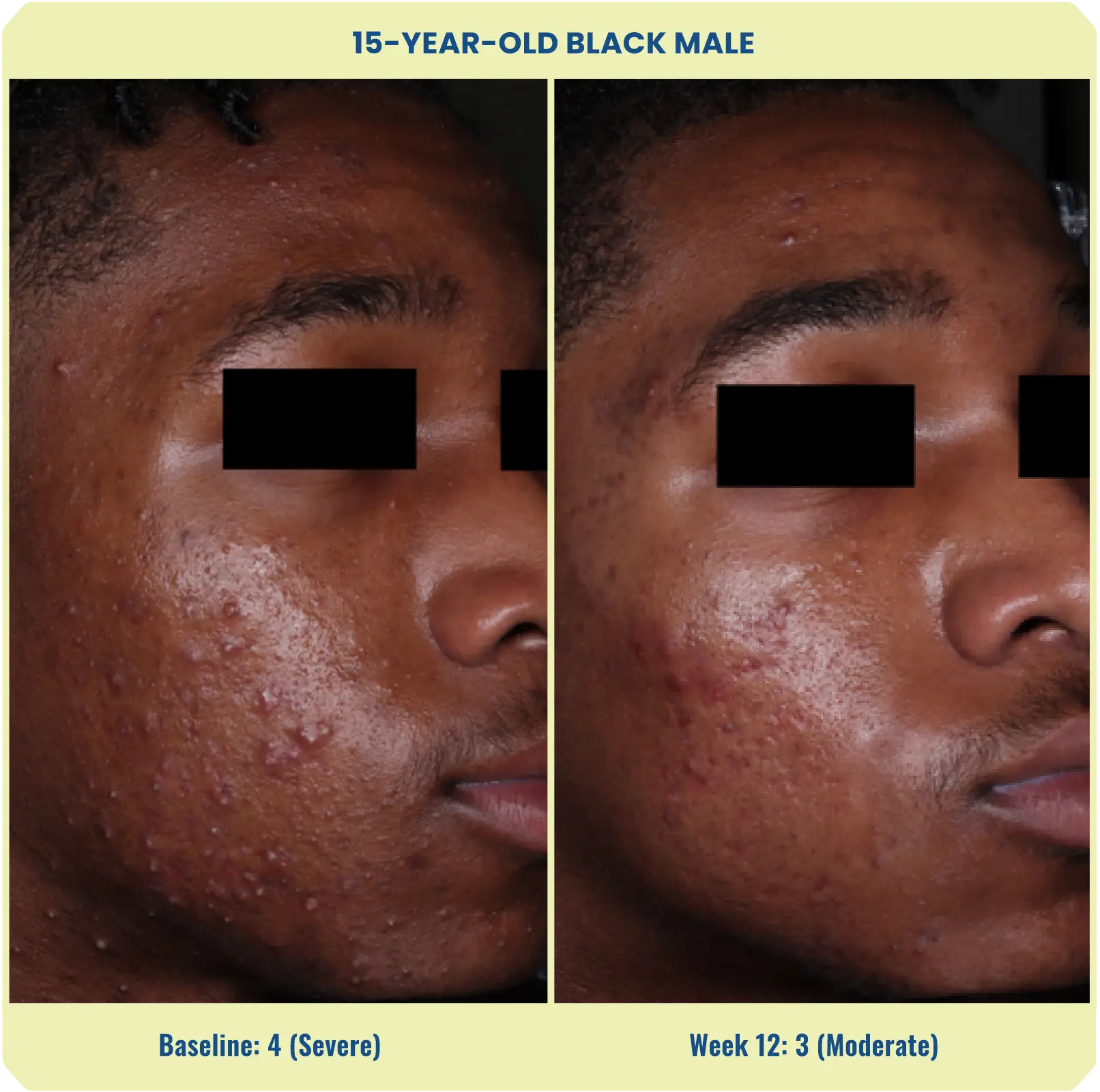
- Banseline 4 (Severe)
- Week 12: 3 (Moderate)
- Inflammatory Lesion Count: 65
- Inflammatory Lesion Count: 24
- Noninflammatory Lesion Count: 77
- Noninflammatory Lesion Count: 34
Individual results may vary.
17-YEAR-OLD WHITE MALE
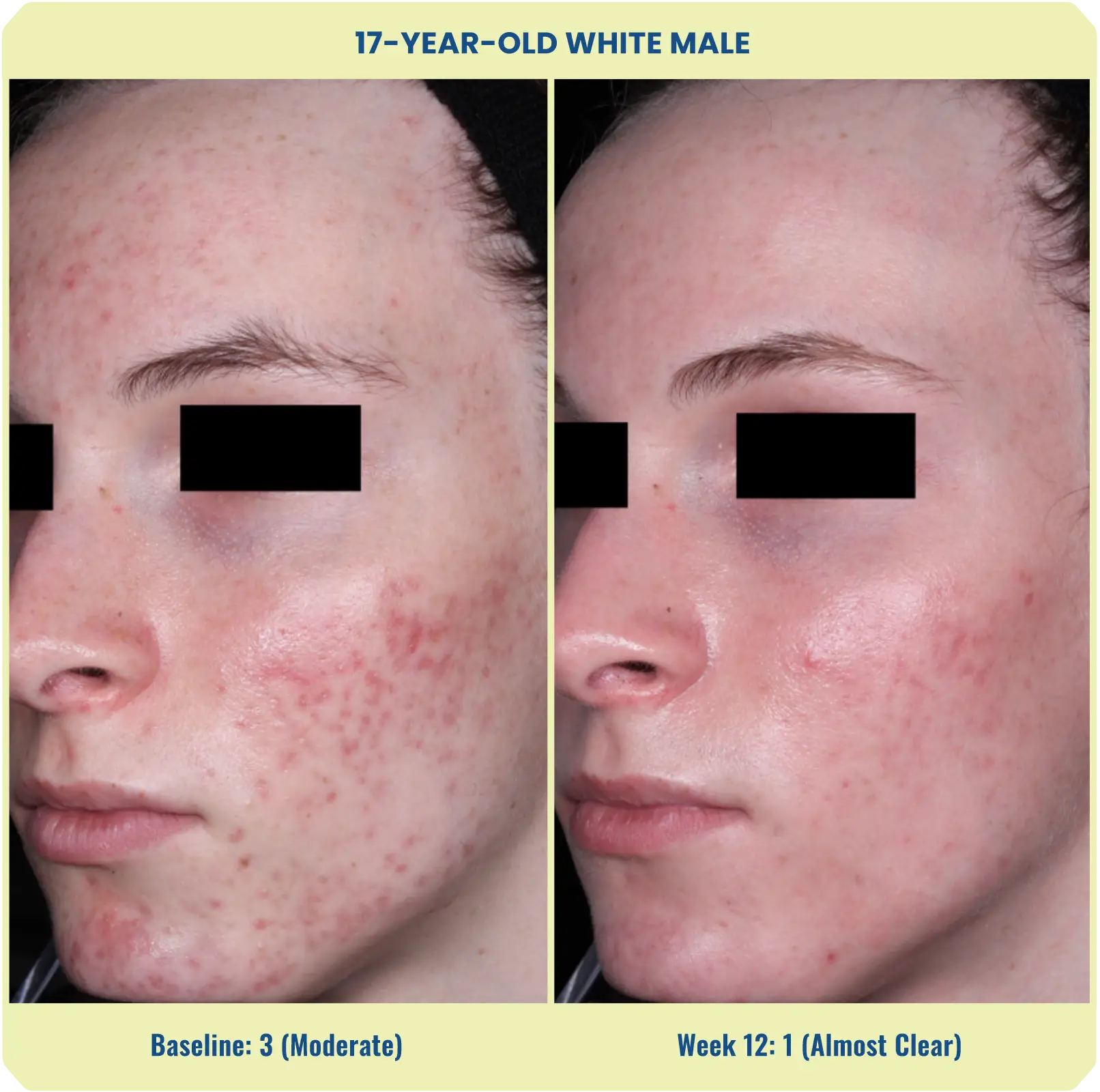
- Banseline 3 (Moderate)
- Week 12: 1 (Almost Clear)
- Inflammatory Lesion Count: 30
- Inflammatory Lesion Count: 4
- Noninflammatory Lesion Count: 37
- Noninflammatory Lesion Count: 12
Individual results may vary.
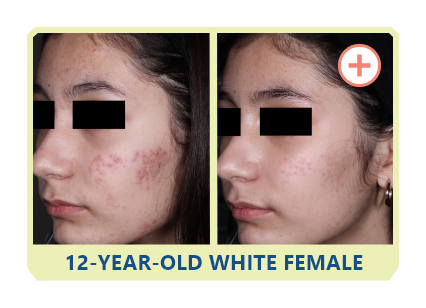

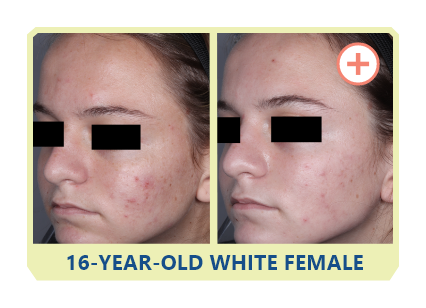
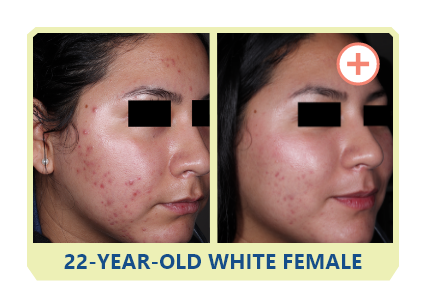
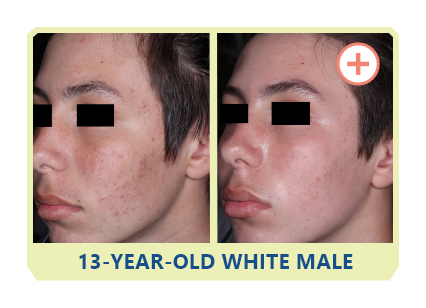
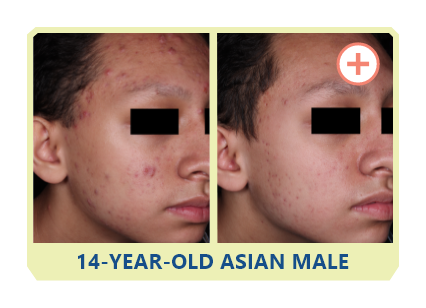
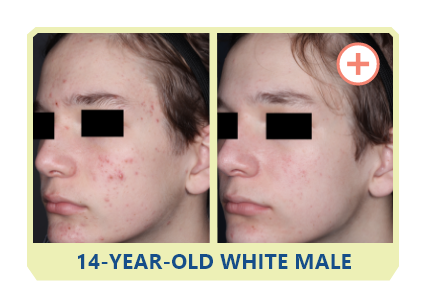

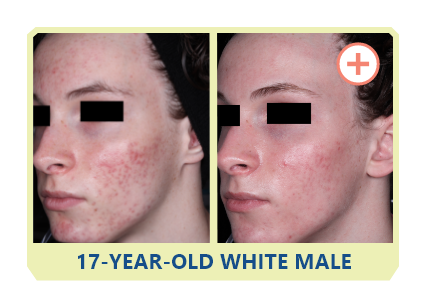
- The safety and efficacy of once-daily CABTREO were assessed in a Phase 2 double-blind, multicenter, randomized, 12-week study of 686 subjects aged 12 years and older with moderate to severe acne vulgaris1
- Subjects were randomized in a 2:2:1:1 ratio into four treatment groups: 220 subjects received once-daily CABTREO (stored at 2-8 °C), 220 subjects received Epiduo Forte (stored at room temperature), 110 subjects received vehicle (stored at 2-8 °C, vehicle group 1), and 110 subjects received vehicle (stored at room temperature, vehicle group 2)1
- Enrolled subjects had a score of moderate (3) or severe (4) on the Evaluator’s Global Severity Score (EGSS), 30 to 100 inflammatory lesions (papules, pustules, nodules), and 35 to 150 non-inflammatory lesions (open and closed comedones)1
- The coprimary efficacy endpoints of success on the EGSS, absolute change in inflammatory lesion count, and absolute change in non-inflammatory lesion count were assessed at Week 12. Treatment-emergent adverse events and cutaneous safety/tolerability were also assessed1
- The safety and efficacy of once-daily CABTREO were assessed in a Phase 2 double-blind, multicenter, randomized, 12-week study of 686 subjects aged 12 years and older with moderate to severe acne vulgaris1
- Subjects were randomized in a 2:2:1:1 ratio into four treatment groups: 220 subjects received once-daily CABTREO (stored at 2-8 °C), 220 subjects received Epiduo Forte (stored at room temperature), 110 subjects received vehicle (stored at 2-8 °C, vehicle group 1), and 110 subjects received vehicle (stored at room temperature, vehicle group 2)1
- Enrolled subjects had a score of moderate (3) or severe (4) on the Evaluator’s Global Severity Score (EGSS), 30 to 100 inflammatory lesions (papules, pustules, nodules), and 35 to 150 non-inflammatory lesions (open and closed comedones)1
- The coprimary efficacy endpoints of success on the EGSS, absolute change in inflammatory lesion count, and absolute change in non-inflammatory lesion count were assessed at Week 12. Treatment-emergent adverse events and cutaneous safety/tolerability were also assessed1

Important Safety Information AND INDICATION
CONTRAINDICATIONS
CABTREO is contraindicated in patients with:
- known hypersensitivity to clindamycin, adapalene, benzoyl peroxide, any components of the formulation, or lincomycin.
- history of regional enteritis, ulcerative colitis, or antibiotic-associated colitis.
Important Safety Information AND INDICATION
CONTRAINDICATIONS
CABTREO is contraindicated in patients with:
- known hypersensitivity to clindamycin, adapalene, benzoyl peroxide, any components of the formulation, or lincomycin.
- history of regional enteritis, ulcerative colitis, or antibiotic-associated colitis.
WARNINGS AND PRECAUTIONS
Hypersensitivity: Hypersensitivity reactions, including anaphylaxis, angioedema, and urticaria, have been reported. If a serious hypersensitivity reaction occurs, discontinue CABTREO immediately and initiate appropriate therapy.
Colitis: Clindamycin can cause severe colitis, which may result in death. Discontinue CABTREO if diarrhea occurs.
Photosensitivity: CABTREO may increase sensitivity to ultraviolet light. Avoid or minimize exposure to sunlight and sunlamps. Wear sunscreen and protective clothing when sun exposure cannot be avoided.
Skin Irritation and Allergic Contact Dermatitis: Stinging/burning/pain, erythema, dryness, irritation, exfoliation, and dermatitis may occur with use of CABTREO and may necessitate discontinuation. Weather extremes, such as wind or cold, may be irritating to patients under treatment with CABTREO. Depending upon severity, patients can use a moisturizer, reduce frequency of application, or discontinue use. Avoid applying CABTREO to areas of broken, eczematous, or sunburned skin, and concomitant use with other potentially irritating topical products. Avoid use of “waxing” as a depilatory method on skin treated with CABTREO.
Use of CABTREO with concomitant topical acne therapy has not been evaluated.
ADVERSE REACTIONS
The most common adverse reactions (occurring in >1% of the CABTREO group and greater than the vehicle group) were application site reactions, pain, erythema, dryness, irritation, exfoliation, and dermatitis.
DRUG INTERACTIONS
Use CABTREO with caution in patients receiving neuromuscular blocking agents.
To report SUSPECTED ADVERSE REACTIONS, contact Bausch Health US, LLC at 1-800-321-4576 or FDA at 1-800-FDA-1088 or www.fda.gov/medwatch.
Indication
CABTREO (clindamycin phosphate, adapalene and benzoyl peroxide) Topical Gel 1.2%/0.15%/3.1% is indicated for the topical treatment of acne vulgaris in adult and pediatric patients 12 years of age and older.
Please click here for full Prescribing Information.
References: 1. Ortho Dermatologics. Data on file.